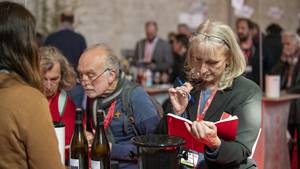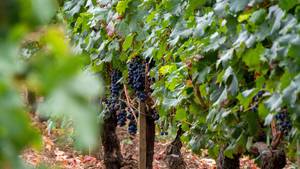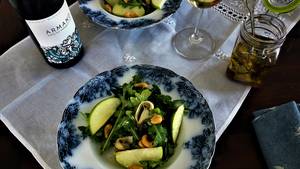“Friendly Manitoba”, adorns the license plates of Manitobans. This is reflected in the confluence of the many nationalities that have found a home on the Canadian prairies, where astounding sunsets provide the promise of a beautiful tomorrow. The variety of cultures that have come to call Winnipeg and the surrounding towns home, also brought with them their traditions of dancing and food. Of the melting pot nature of Manitoba Felix Faundez-Rubio, Runner-up at the Best Sommelier of Manitoba 2021 contest, says “two of the most identifiable cultures in Manitoba are Ukrainian and Polish. The food of both are based on a heart-warming and flavourful mixture of pork sausages, sauerkraut, dill and soft dough. These elements, present themselves across central Europe, can be found in areas where cool weathers call for comforting food and wines; areas such as Germany’s Mosel and Rheingau.”
In terms of his favourite German wines Faundez-Rubio praises “Riesling for its lively acidity which keeps its freshness when paired with dishes. German Rieslings often also have a slight touch of sweetness for contrast in the mouth. However, several regions have focused on wines that will express the graciousness of the grape in dry versions. Words that will help identify a dry German Riesling are “trocken” (literally: dry), and “Grosses Gewächs” (“Great Growth”), a classification term that always denotes a great-site wine, dry in style.”
Sitting on the Mosel River, the steep slopes of the Mosel wine region offer a variety of styles following the Prädikat scale, from bone dry to fairly sweet Rieslings. According to Faundez-Rubio “the key factor to enjoy a good bottle of Riesling is the balance of acidity that it displays, and such balance is achieved thanks to the particular conditions of the terroir of the Mosel. Vineyards on steep slopes with the best sun exposure allow the grapes to ripen properly in cold climate of the Mosel. The river itself reflects the sunlight and keeps the heat of the day to release it uphill during the cooler nights. The blue and red slate soils in the region define floral and delicate or richer and muscular wines, respectively, and add salty minerality that makes structured, sharp Rieslings.”
According to Faundez-Rubio, the structure of the wines make a great complement for the generous flavours of pierogi, kielbasa, dill pickle soup, borscht, and gołąbki / holubtsi (cabbage rolls).
“One day your heart will find a reason to take you to the flat lands of Manitoba. Either it is this experience or another reason, do not miss out enjoying some of this hearty food with an outstanding German Riesling. You will see there is nothing flat about flavours here,” concludes Faundez-Rubio.
Gołąbki (Polish Stuffed Cabbage Rolls)
1 head white cabbage
2 tbsp butter
1.7 lb ground pork
1 large onion, chopped
1 tsp finely chopped garlic
½ cup cooked rice
1 tbsp dried marjoram
1 l chicken stock
Salt, to taste
¼ tsp ground black pepper
A handful of chopped dill or parsley, to garnish (optional)
Tomato Sauce:
⅓ stick (30 g) butter
1 tbsp all-purpose flour
1 cup remaining stock
2 cups tomato purée
1 tbsp tomato concentrate
A pinch of sugar
Salt, to taste
¼ tsp ground black pepper
Directions: Bring a large pot of lightly salted water to a boil. Cook the cabbage head in water, with a cover, for 3 minutes. Remove the cabbage from the pot and let it sit until the leaves are cool enough to handle. Keep the water in the pot. Remove and set aside 15–18 whole leaves from the cabbage head, cutting out any thick parts. Chop the remainder of the cabbage and spread it in the bottom of a casserole.
Melt butter in a large skillet over medium-high heat and add chopped onion. When it turns golden, add chopped garlic and fry for another 1–2 minutes. Cool. In a large bowl, combine the ground pork, cooked rice, marjoram, and onion/garlic. Preheat oven to 350 °F (175 °C). Place about 1/2 cup of the mixture on a cabbage leaf. Roll the leaf around the mixture, tucking in the sides. Do this with 10 leaves. Place the rolls on top of the chopped cabbage in the casserole and season with salt and black pepper. Cover with a layer of remaining leaves. Gently, pour the stock in and cook on a medium heat, covered, for about 40–50 minutes until the cabbage is tender.
After the rolls are cooked, for the tomato sauce, melt the butter in a saucepan and then add in the flour. Whisk together and cook until it gains some colour. Pour in a cup of the stock used to cook the rolls. Bring to a boil, then reduce the heat. Pour in the tomato purée and add the tomato concentrate. Bring to a boil again, then reduce the heat to a minimum. Season with salt and ground pepper. If the sauce feels too acidic, add a pinch of sugar, to balance. Pour the sauce over the cabbage rolls and cover with aluminium foil. Bake in the oven for 1 hour.
Note: Polish and Ukrainian cabbage rolls are similar, and the meat in their fillings may include beef and/or pork. In holubtsi, from Ukraine, the stuffing often has potato, and they can be prepared with or without meat.







